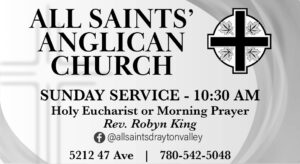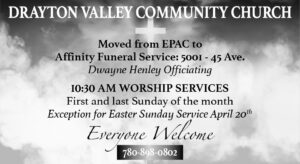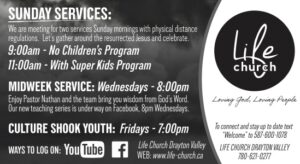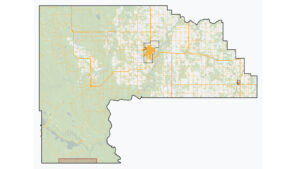Corey Peebles wants to lead Drayton Valley forward over the next four years, and believes he has the vision to do so. Last week the two-term councillor announced that he’ll be running for mayor in the October municipal election.
Peebles moved to Drayton Valley as a child in the mid-1990s. He was first elected to council in 2010 and served for three years. He didn’t run in 2013 but returned and began his second term in 2017. After serving as a youth pastor for several years Peebles opened his first business in 2014. He is now co-owner of three gyms, including one in Drayton Valley.
After living in the community for 25 years he says he’s seen the town at both its “highest highs” and its “lowest lows.” Through it all Peebles remains a self-described optimist. As restrictions from the Covid-19 pandemic ease he’s keen to talk about what the coming years hold for the community.

Church of God
Drayton Valley Church of God. Our Worship Services usually include: traditional hymns, praise choruses, and contemporary songs, prayer, scripture, and a sermon.

All Saints Anglican Church
Drayton Valley, All Saints Anglican Church participates in the Anglican Liturgy, which comforts and sustains us. Many have said that in such a busy and changing world it is important to come to a place that feels like home.

Breton Dental Clinic
Share on facebook Facebook Share on email Email Share on linkedin LinkedIn Share on whatsapp

Emmaus Lutheran Church
A community of faith passionately walking the road of life with the Lord Jesus. Phone: 780-542-5101, Drayton Valley Alberta

St. Anthony Catholic Church
St. Anthony’s Parish Drayton Valley. Weekend mass Saturday and Sunday
“I think the future is looking great in Drayton Valley again,” he says, citing returning strength in our traditional industries, along with a gradual diversification of the local economy. Peebles says he’ll always support the oil and gas industry, which has long provided the foundation of the local economy. He’d like to see the expertise garnered from oil and gas used to diversify and attract new industry to the area. That includes opportunities from the manufacturing sector rather than just the production of raw materials.
“We have so many trades in this community, and so many jobs can come out of value-added,” he says.
In January 1965, the St. Anthony School opened its doors. Now, 60 years later, the school is planning a celebration of the milestone.
Principal Janelle Molzan says they are planning to have a celebration on May 24 at the school gym. They will be using the event to also fundraise for the school.
Molzan says they will have a band performing that evening, catering from a local restaurant, a full cash bar, as well as some door prizes.
Part of the celebration will also be the fact that St. Thomas Aquinas Roman Catholic School Division has put St. Anthony at the top of their priority list for a new school. Molzan says the division has to wait until next year to submit their request to the Province, and there is no guarantee that they will be selected for funding.
“It could be anywhere from two to ten years,” she says. “Or more.”
However, she feels that St. Anthony has a strong case for asking for a new school.
The most recent remodel of the school was in 1992, says Molzan. At that point they expanded the school, removing the gym from the centre of the school and installing classrooms instead. The new gym was then built as an addition to the school.
“We had the addition of the gym as well as a few classrooms in 1992,” says Molzan.
Since then, there have been no major remodels or renovations. Instead, the staff have been doing what they can to keep the building in shape.
“It’s a really well built school,” says Molzan.
She says over the years, the natural heaves and settling that occur with temperature fluctuations has led to some cosmetic damages to the building. “It’s just showing its age,” she says.
While the school is starting to show wear, Molzan says there are no capacity issues. About 15 years ago, the school went from being a K-12 school to a K-8 school when the Holy Trinity Academy was built.
Molzan says if they don’t get a new school they will have to pursue getting more renovations or remodeling for the current building.
New trespassing program helps businesses
Businesses will now have another option for dealing with trespassers thanks to a new program that Enforcement Services have put into place.
Cody Rossing, the manager of enforcement services and emergency management for the Town, says one of the biggest challenges for businesses in the community who were issuing trespass notices is that someone has to attend court in order for the trespassing charge to stick. With the new Trespassing Agent program which comes into place on March 20, businesses who enrol will not have to attend court.
Previously, businesses who contacted the RCMP to report a trespasser had to issue the trespass notices themselves.
For many businesses the process didn’t work well. Larger franchises, like banks, found arranging the issue of a trespass notice and attending court was not logistically feasible. Small business owners, on the other hand, could issue the notice but may have to close their business in order to attend court.
Rossing says there are two different pieces of legislation that speak to trespassing, the Petty Trespass Act and the Trespass to Premises Act.
“Under both of the legislations, the property owner or their agent are required to provide trespass notices, help get people off of their land, and stuff like that,” says Rossing.
The first offence fine under the provincial legislation is normally $600, but it could be up to $10,000. A second offence could have a fine of up to $25,000
The higher fines come into place when the individual ignores the notice and returns to the property. If the trespasser returns three times, the officers can then issue a summons to court. If they fail to attend, a warrant is issued, and at that point if they are found guilty, the higher fines can be given.
Rossing says the program is helping streamline the process for businesses. If they choose to enrol in the program, it will allow peace officers or the RCMP to act as their agent and issue the notices. It also means the business owners won’t have to attend court.
“Court is scary for a lot of people, and we understand that,” says Rossing.
The purpose of the program is to improve the process because officers are continuing to get calls to the same place over and over and business owners or their employees are uncomfortable with the court process. Until now, there hasn’t been any way to address those issues.
“It’s been a lot of work on the back end because there is no follow up process in place and there is no trespass notice being issued,” says Rossing.
He says the hope is that by having this program in place, businesses can sign up and they can begin to address the issue more efficiently.
Several different municipalities in the province have a similar program in place, says Rossing. While developing the program, Rossing did research on other initiatives and reached out to other municipalities that had something similar in place. He says he wanted to be sure that he had everything in place before he announced the program in the community.
There are also checks and balances that have been worked into the program.
“If you’re trespassed from a local business, one of our officers shows up and says you’re trespassed for six months, if you don’t agree with it, you can appeal that process,” says Rossing.
He says there is also the option for the business owners to speak with the officer and reduce the amount of time the individual is trespassed for. In some cases, if the RCMP issue a notice that’s in effect for six months, a business owner may come forward and advocate for the trespasser if the individual doesn’t normally behave in that manner
“They can say, ‘This person is normally a good customer, but there is something going on with him right now. I think maybe a month would be more appropriate,’” says Rossing.
However, it is ultimately the final discretion of the officer.
Once a business is enrolled in the program, they will receive a sticker that they can place in a conspicuous area that is easily visible for officers. If they receive a call, the officer will know that they can issue the notice themselves rather than speaking to the owner and explaining the process that has to take place.
Rossing says enrolment in the program is free, and he encourages businesses to sign up if they are having consistent issues with people loitering or being a nuisance on their property. Those who are interested in enrolling can visit www.draytonvalley.ca/enforcementservices/trespassingagent and fill out the form. They can then email it in to enforcement@draytonvalley.ca or drop it off at the Town office.
Technology bring collisions into focus
There are approximately 187 accidents in town each year within Town limits. That’s according to data from Drayton Valley Enforcement Services.
Cody Rossing, the Manager of Enforcement Services and Emergency Management for the Town, says data from 2016-2023 has helped map out intersections in the community that sees the highest number of collisions. The intersection at 50 Street North and Hwy 22 has had eight collisions, the highest in the community. The second highest number was at the intersection of 50 Street and 50 Avenue.
“Anything along Highway 22, the Town doesn’t have jurisdiction over, pertaining to road designs or changes,” says Rossing.
He says getting the data from the Province regarding collisions along Highway 22 is something they haven’t been able to do before. Now that they have the data they can start mapping out the high incident intersections and starting brainstorming ways they can address some of the problem areas. Rossing says those areas will have more focus from the community peace officers.
Rossing says they are trying to develop strategies on how to reduce collisions in the community on a whole, particularly those that result in fatalities.
“There’s different things we can use like engineering and controls,” says Rossing. “But for enforcement services, how are we strategically educating and enforcing in those areas?”
He says there are a number of factors that can contribute to collisions. Over the past eight years there have been 434 caused from unsafe speeds, 245 were intersection related, 163 that are weather related, 114 from road surface conditions, 51 involving animals, and 417 were from drivers performing improper actions.
With speed being the most prominent cause, enforcement services have been taking action to find out where speeding is most common and increasing patrols. The digital speed signs that were purchased with funds from the Community Safety Committee don’t have cameras on them, but they do record the speed and report that data back to enforcement services.
On March 6, officers intercepted a vehicle driving 102 km per hour in a 50 km zone.
“That vehicle was pulled over, a court summons was issued to the driver to compel them to court. If they don’t attend court a warrant will be issued for them,” says Rossing.
If they are found guilty, they could face a fine of up to $2,000 and/or a license suspension.
Rossing says anyone who is over the speed limit by more than 51 km per hour will face an automatic court summons.
This was not the only incident of speeding. On March 5, the digital speed signs picked up on a vehicle driving 111 km per hour in a 60 km per hour zone. They also pulled over a vehicle going 50 km per hour over the limit that same day.
“That is strictly within the Town of Drayton Valley boundaries,” says Rossing.
There are a number of reports enforcement services can get from the digital signs, including the amount of traffic on a road and the times that see the most traffic. Using this data, enforcement services can ensure they deploy units during the busiest times of the day to the areas where speeding is common.
What you see is what you get
Like William Shatner, Mike Myers, Wayne Gretzky’s dad and God help us, Celine Dion, here at the Free Press, we are Canadian.
There’s been a lot of talk recently about US ownership of some of this country’s most prominent businesses and institutions. At the Free Press we are certainly not prominent, nor do we want to be institutionalized. But still, it seems like a good time to point out to anyone who’s interested, that we are exactly what we appear to be.
We are 100 percent locally owned. There are no hidden shareholders or outside interests. All of our staff live in either Drayton Valley or Brazeau County, apart from our designer, Brittany. She’s from here, but currently telecommutes from somewhere in British Columbia, which I have to confess, makes me a little jealous sometimes.
What else can I tell you? The Free Press is printed for us by some nice people in St. Albert. The printing press is owned by Great West Newspapers, which is also a Canadian company.
The paper we’re printed on comes from the Alberta Newsprint Corporation in Whitecourt. Incidentally, the paper is made from offcuts and waste from the lumber industry so we’re not cutting down trees to make the paper.
Once the paper has been printed it’s picked up and brought back to town by Drayton Valley’s own Rocket Express. At that point it’s back to us as we deliver it throughout the community.
Now you may be wondering why I’m telling you all this. Would the Americans really be interested in owning a tiny little paper in a small town in Alberta?
Well, you’d be surprised. A good chunk of Canada’s print media is currently in American hands, and that includes a number of community newspapers in this province. Postmedia is 66 percent owned by Chatham Asset Management, a hedge fund based in New Jersey. Who are Postmedia? They are the owners of the National Post, the Calgary Herald, the Edmonton Journal, the Calgary Sun, the Edmonton Sun and a host of other newspapers, both large and small, from coast to coast.
That situation may not be quite as bad as it sounds. I was the editor of the Drayton Valley Western Review (kids, ask your grandparents) for 10 years. During my time there the paper was owned by a succession of large, soulless corporations based in central Canada. They did absolutely nothing to impact the way we covered the news. I barely heard a peep in over a decade. I always suspected that was less to do with high journalistic standards at corporate headquarters, and more down to the fact they were only dimly aware we existed and probably couldn’t find Drayton Valley on a map, but either way the effect was the same.
So corporate ownership, whether it’s American or not, probably isn’t the best thing ever, but it isn’t necessarily fatal to Canadian news.
But I do think there’s an important distinction between a paper like the Free Press and some of the others; and it’s this. If you take out a subscription or buy an advertisement with us you can be confident that your money is staying close to home. And especially these days, that seems like a good investment.
Local auctioneer takes the championship
A local auctioneer has chanted his way into the history books after securing himself a first place position at the 2025 Canadian All Around Auctioneer Championship.
Prior to the 2025 CAAAC, Justin Mayer had already earned a trophy at the 2020 Canadian Bid Catching Competition. He is the first to hold a title for both competitions.
Mayer, at 29-years-old, says he’s been participating in the CAAAC for more than a decade. His mentors and many of the auctioneers he grew up listening to have all competed in the competition and some have won.
“It’s a pretty prestigious award,” says Mayer.
A good auctioneer is someone who can present themselves in a professional manner, with confidence in your body language and hand gestures. They have to be well spoken and comfortable with public speaking. The auctioneer chant, which requires rhythm, clarity, and speed to be considered such, is also an important technique that auctioneers must master.
“You should be able to almost dance to an auctioneer’s chant,” says Mayer
When he entered the CAAAC, Mayer participated in two rounds. The preliminary round ruled out everyone except for the top five. Those five then moved onto the final round.
In both rounds, five judges ranked their skills on a scorecard, and the person with the best overall ranking took home the award.
Mayer is not the first member of his family to take home the CAAAC title. His uncle Ron Sekura also held the title, and for Mayer, that makes the win even sweeter.
“He’s passed on, so it’s pretty cool for me to have the title with him,” says Mayer.
As a kid, Mayer was surrounded by some of his biggest mentors in the auctioneering world. His uncle, stepfather Corey Sekura, and grandfather, Wendell Sekura, all encouraged his love of auctioning.
He says he loves the sport because of the high energy atmosphere and the chance to meet people.
“When you’re up on the stand in front of the crowd selling, it’s up to me to present, in lots of cases, people’s livelihoods and their entire life, whether you’re selling a farm or a disbursement sale. It’s up to you, as the auctioneer, to generate excitement and do your homework in front of the crowd in order to bring top dollar for people,” says Mayer.
Over the years, Mayer has met many people and he says he enjoys the connections
“I know somebody from every town,” he says.
Now that he’s taken the title for the CAAAC, he is eligible for the International All Around Auctioneer Championship and from there he can head off to the World Championship.
For many, the decision to go to the international championship would be easy, but Mayer says he’s not sure what he’s going to do.
“I grew up in an auction family, and for me and my family to win this competition was a big deal,” says Mayer. “Now that I’ve won it, I kind of feel like I achieved what I wanted.”
However, Mayer has been receiving encouragement from Rob Bergevin, a Canadian International and Worlds competitor, to go to the International Championship.
“I beat him this year and he’s really trying to convince me to go to the International because he thinks I have a shot at it,” says Mayer.
Mayer’s love of auctioneering resulted in him going to Western College of Auctioneering in Billings, Montana in 2013. Since then, he’s been building up his reputation as an auctioneer across Alberta and British Columbia.
He says his uncle and stepfather were always in his ear, pointing out areas where he could do better and giving him advice to improve his skill.
“Grandpa Wendy was a big factor in that as well,” says Mayer.
For several years, Mayer spent a lot of time travelling to municipalities across the province and British Columbia to local auctions. However, once the pandemic hit, many auction houses opted for online auctions as a way to still run the business while meeting government regulations. Since that time, it’s not uncommon for auctions to be held online.
“But I still travel around,” says Mayer. “I still do lots of auctions. I’m never going to stop. It’s too exciting.”
Over the years, Mayer has worked for Team Auctions, as well as auctioning off classic cars. He also works for a lot of charity auctions.
When his children were younger, they struggled with the amount of time that Mayer was away. Now that they’re older, he says they appreciate it more. His daughter has even been asking for lessons, and has been practicing reading off a list of numbers that she has on her wall.
Mayer says he’s grateful to everyone for their support and encouragement over the years.
“I’m tremendously thankful to my mom, my dad, the Sekura family, my wife and my kids. They have all been there for me. They’ve all shaped me,” says Mayer. “Probably my biggest influence in all of it was my Uncle Ron, and my dad, Corey. They really shaped me and supported me.”
Charter school proposal moving forward
Members of local indigenous groups are working toward opening a charter school with the goal of offering students an education that goes beyond academics.
Charlene Bearhead, a member of the board for the Roots of Resilience not-for-profit society, says the group is applying to the Minister of Education to be able to open a charter school in Drayton Valley, with a goal of opening in September.
The society is hosting an information night on February 13 from 5-7:30 p.m. at the Holiday Inn Express.
Bearhead says her 40 years of working in education has made it clear that the system is failing children and staff as human beings.
“I’m always a big believer in doing the best you can to try to work with what exists already and do what you can to help guide that,” says Bearhead.
She worked within the system, and recently served as a school board trustee, but she says people weren’t ready to progress with changes she feels need to be made.
The goal of opening the charter school is to offer a learning experience that encompasses a child’s entire wellbeing, including mental and spiritual health, along with teaching Alberta’s curriculum. While the students will learn from methods that indigenous people have always used for passing on knowledge, Bearhead says the school isn’t just open to indigenous children. Any child in the area from Kindergarten to grade 12 will be welcome to attend.
One thing that Bearhead wants the public to be aware of regarding charter schools is that they are still public schools. Roots of Resilience will be funded in the same manner that Wild Rose School Division and the St. Thomas Aquinas Roman Catholic School Division are.
“One lady said to me, ‘This sounds so amazing Charlene, but I really struggle with anything that takes away from public schools,’” says Bearhead. “I had to say to her ‘This is public education. This is public school.’”
She says there are only provisions for charter schools in Alberta. Charter schools receive the same funding for facilities, transportations, and other expenses, and the same requirements to follow the Alberta curriculum and the Education Act. Just like any other public school, parents do not have to pay extra to enrol their children in a charter school.
“But they are intended to be schools of choice,” says Bearhead. “They give parents and kids a choice in their education.”
However, charter schools are not without controversy. According to the website of Alberta Teachers’ Association, “there is only one pot of money for schools in Alberta. When money is diverted to private and charter schools, it leaves public schools in a funding shortfall.”
Bearhead says charter schools have to offer a unique approach to education that isn’t available in the geographic area. Bearhead says it’s important to the RoR society to define the holistic success for the school, which means the students will be doing better in body, mind, and soul, as well as academically.
She says that pushing people hard to do well academically while ignoring all other aspects of the student’s progress doesn’t work well. For Bearhead, it’s important for educators to meet the students where they’re at, value them as human beings, offer them a safe environment, and offer opportunities for the students to see themselves reflected in what is being taught.
Along with the regular curriculum, Bearhead says they plan to offer language programs for those who are interested in learning the language of their ancestors to help those students connect with their heritage.
Wendy Snow, the Interim District Captain in the Otipemisiwak Metis Government for District Eight and member of the RoR society, says she feels her own children would have benefitted from what the proposed school will be offering.
Snow says she has two children as well as a niece that she is the guardian of. With all three of them going to school in Drayton, she says they went to almost every school in the community.
“I found that it was very lacking as far as teaching to our culture,” says Snow.
She says every year she would fill out the demographic forms, indicating that her children were indigenous, knowing that the school division would get additional funding for those students.
“I found that all of the funding in the Wild Rose School Division went to Rocky Mountain House,” she says. “All the programming, all the culture stuff, everything went to Rocky Mountain House.”
Like Bearhead, Snow wanted to work with the system and try to help improve things. She ran twice for school board trustee, but did not get elected.
“I’ve always wanted to see more funding and programming and culture stuff in this area, just like there is in Rocky Mountain House,” says Snow.
Bearhead says the RoR school will resonate with indigenous children.
“An indigenous pedagogy, or approach to education, is about physical, mental, social, emotional, and spiritual [well-being]. Whatever that means to you. Everyone is indigenous to somewhere,” says Bearhead.
She says public charter schools are smaller and have unique approaches to education.
“They are actually intended to be models for how education could happen in any or all public schools,” she says.
Bearhead says when the students see themselves reflected in the content they’re learning, they have a better chance of relating to it and absorbing it.
By making the students the centre of the system, educators can focus on the whole child, not just the content they’re supposed to be learning. She says each student has different strengths, weaknesses, interests, and paths. In their school, they plan to help students excel at their strengths, offer support for their weaknesses, and encourage their interests and plans.
Another important part of education is offering the students a safe space.
“If kids are terrified, if kids are being bullied, if kids don’t feel safe, how can they focus on learning?” says Bearhead. “That’s just human instinct. That’s survival.”
She says if students are feeling ostracized, alienated, or left out, it’s more challenging for them to learn.
Roots of Resilience will also offer hands-on learning for students. This experiential learning will be land-based, which means there will be more of a balance between indoor and outdoor learning. She says there are many different areas of the curriculum that can be taught outdoors beyond science and physical education.
“For me, when you do something, rather than just read about it or hear about it, it becomes ingrained in you,” she says.
Snow says she wants to see children in the area have an opportunity to choose an education that best suits them.
“I think it just gives them a great basis for success later on in life,” says Snow.
That increased economic strength is part of a broader vision which would see Drayton Valley continue to grow as people from other parts of the province learn the benefits of living in a small community that boasts good amenities and is relatively close to both an international airport and a major highway system, while having easy access to the kind of recreational activities found in and around this area.
“Here you can get 25 percent more house for 25 percent less money than in the city. We’ve got two brand new schools, the pool’s being built. There’s the pump track,” he says. “We’re creating the recipe for a community that is so great and so strong.”
An important piece of the puzzle is to get the message about what Drayton Valley has to offer out to the rest of the province and beyond. That means finding a way to let others know about the strengths of the community and the quality of life available here.
In January 1965, the St. Anthony School opened its doors. Now, 60 years later, the school is planning a celebration of the milestone.
Principal Janelle Molzan says they are planning to have a celebration on May 24 at the school gym. They will be using the event to also fundraise for the school.
Molzan says they will have a band performing that evening, catering from a local restaurant, a full cash bar, as well as some door prizes.
Part of the celebration will also be the fact that St. Thomas Aquinas Roman Catholic School Division has put St. Anthony at the top of their priority list for a new school. Molzan says the division has to wait until next year to submit their request to the Province, and there is no guarantee that they will be selected for funding.
“It could be anywhere from two to ten years,” she says. “Or more.”
However, she feels that St. Anthony has a strong case for asking for a new school.
The most recent remodel of the school was in 1992, says Molzan. At that point they expanded the school, removing the gym from the centre of the school and installing classrooms instead. The new gym was then built as an addition to the school.
“We had the addition of the gym as well as a few classrooms in 1992,” says Molzan.
Since then, there have been no major remodels or renovations. Instead, the staff have been doing what they can to keep the building in shape.
“It’s a really well built school,” says Molzan.
She says over the years, the natural heaves and settling that occur with temperature fluctuations has led to some cosmetic damages to the building. “It’s just showing its age,” she says.
While the school is starting to show wear, Molzan says there are no capacity issues. About 15 years ago, the school went from being a K-12 school to a K-8 school when the Holy Trinity Academy was built.
Molzan says if they don’t get a new school they will have to pursue getting more renovations or remodeling for the current building.
Businesses will now have another option for dealing with trespassers thanks to a new program that Enforcement Services have put into place.
Cody Rossing, the manager of enforcement services and emergency management for the Town, says one of the biggest challenges for businesses in the community who were issuing trespass notices is that someone has to attend court in order for the trespassing charge to stick. With the new Trespassing Agent program which comes into place on March 20, businesses who enrol will not have to attend court.
Previously, businesses who contacted the RCMP to report a trespasser had to issue the trespass notices themselves.
For many businesses the process didn’t work well. Larger franchises, like banks, found arranging the issue of a trespass notice and attending court was not logistically feasible. Small business owners, on the other hand, could issue the notice but may have to close their business in order to attend court.
Rossing says there are two different pieces of legislation that speak to trespassing, the Petty Trespass Act and the Trespass to Premises Act.
“Under both of the legislations, the property owner or their agent are required to provide trespass notices, help get people off of their land, and stuff like that,” says Rossing.
The first offence fine under the provincial legislation is normally $600, but it could be up to $10,000. A second offence could have a fine of up to $25,000
The higher fines come into place when the individual ignores the notice and returns to the property. If the trespasser returns three times, the officers can then issue a summons to court. If they fail to attend, a warrant is issued, and at that point if they are found guilty, the higher fines can be given.
Rossing says the program is helping streamline the process for businesses. If they choose to enrol in the program, it will allow peace officers or the RCMP to act as their agent and issue the notices. It also means the business owners won’t have to attend court.
“Court is scary for a lot of people, and we understand that,” says Rossing.
The purpose of the program is to improve the process because officers are continuing to get calls to the same place over and over and business owners or their employees are uncomfortable with the court process. Until now, there hasn’t been any way to address those issues.
“It’s been a lot of work on the back end because there is no follow up process in place and there is no trespass notice being issued,” says Rossing.
He says the hope is that by having this program in place, businesses can sign up and they can begin to address the issue more efficiently.
Several different municipalities in the province have a similar program in place, says Rossing. While developing the program, Rossing did research on other initiatives and reached out to other municipalities that had something similar in place. He says he wanted to be sure that he had everything in place before he announced the program in the community.
There are also checks and balances that have been worked into the program.
“If you’re trespassed from a local business, one of our officers shows up and says you’re trespassed for six months, if you don’t agree with it, you can appeal that process,” says Rossing.
He says there is also the option for the business owners to speak with the officer and reduce the amount of time the individual is trespassed for. In some cases, if the RCMP issue a notice that’s in effect for six months, a business owner may come forward and advocate for the trespasser if the individual doesn’t normally behave in that manner
“They can say, ‘This person is normally a good customer, but there is something going on with him right now. I think maybe a month would be more appropriate,’” says Rossing.
However, it is ultimately the final discretion of the officer.
Once a business is enrolled in the program, they will receive a sticker that they can place in a conspicuous area that is easily visible for officers. If they receive a call, the officer will know that they can issue the notice themselves rather than speaking to the owner and explaining the process that has to take place.
Rossing says enrolment in the program is free, and he encourages businesses to sign up if they are having consistent issues with people loitering or being a nuisance on their property. Those who are interested in enrolling can visit www.draytonvalley.ca/enforcementservices/trespassingagent and fill out the form. They can then email it in to enforcement@draytonvalley.ca or drop it off at the Town office.
There are approximately 187 accidents in town each year within Town limits. That’s according to data from Drayton Valley Enforcement Services.
Cody Rossing, the Manager of Enforcement Services and Emergency Management for the Town, says data from 2016-2023 has helped map out intersections in the community that sees the highest number of collisions. The intersection at 50 Street North and Hwy 22 has had eight collisions, the highest in the community. The second highest number was at the intersection of 50 Street and 50 Avenue.
“Anything along Highway 22, the Town doesn’t have jurisdiction over, pertaining to road designs or changes,” says Rossing.
He says getting the data from the Province regarding collisions along Highway 22 is something they haven’t been able to do before. Now that they have the data they can start mapping out the high incident intersections and starting brainstorming ways they can address some of the problem areas. Rossing says those areas will have more focus from the community peace officers.
Rossing says they are trying to develop strategies on how to reduce collisions in the community on a whole, particularly those that result in fatalities.
“There’s different things we can use like engineering and controls,” says Rossing. “But for enforcement services, how are we strategically educating and enforcing in those areas?”
He says there are a number of factors that can contribute to collisions. Over the past eight years there have been 434 caused from unsafe speeds, 245 were intersection related, 163 that are weather related, 114 from road surface conditions, 51 involving animals, and 417 were from drivers performing improper actions.
With speed being the most prominent cause, enforcement services have been taking action to find out where speeding is most common and increasing patrols. The digital speed signs that were purchased with funds from the Community Safety Committee don’t have cameras on them, but they do record the speed and report that data back to enforcement services.
On March 6, officers intercepted a vehicle driving 102 km per hour in a 50 km zone.
“That vehicle was pulled over, a court summons was issued to the driver to compel them to court. If they don’t attend court a warrant will be issued for them,” says Rossing.
If they are found guilty, they could face a fine of up to $2,000 and/or a license suspension.
Rossing says anyone who is over the speed limit by more than 51 km per hour will face an automatic court summons.
This was not the only incident of speeding. On March 5, the digital speed signs picked up on a vehicle driving 111 km per hour in a 60 km per hour zone. They also pulled over a vehicle going 50 km per hour over the limit that same day.
“That is strictly within the Town of Drayton Valley boundaries,” says Rossing.
There are a number of reports enforcement services can get from the digital signs, including the amount of traffic on a road and the times that see the most traffic. Using this data, enforcement services can ensure they deploy units during the busiest times of the day to the areas where speeding is common.
Like William Shatner, Mike Myers, Wayne Gretzky’s dad and God help us, Celine Dion, here at the Free Press, we are Canadian.
There’s been a lot of talk recently about US ownership of some of this country’s most prominent businesses and institutions. At the Free Press we are certainly not prominent, nor do we want to be institutionalized. But still, it seems like a good time to point out to anyone who’s interested, that we are exactly what we appear to be.
We are 100 percent locally owned. There are no hidden shareholders or outside interests. All of our staff live in either Drayton Valley or Brazeau County, apart from our designer, Brittany. She’s from here, but currently telecommutes from somewhere in British Columbia, which I have to confess, makes me a little jealous sometimes.
What else can I tell you? The Free Press is printed for us by some nice people in St. Albert. The printing press is owned by Great West Newspapers, which is also a Canadian company.
The paper we’re printed on comes from the Alberta Newsprint Corporation in Whitecourt. Incidentally, the paper is made from offcuts and waste from the lumber industry so we’re not cutting down trees to make the paper.
Once the paper has been printed it’s picked up and brought back to town by Drayton Valley’s own Rocket Express. At that point it’s back to us as we deliver it throughout the community.
Now you may be wondering why I’m telling you all this. Would the Americans really be interested in owning a tiny little paper in a small town in Alberta?
Well, you’d be surprised. A good chunk of Canada’s print media is currently in American hands, and that includes a number of community newspapers in this province. Postmedia is 66 percent owned by Chatham Asset Management, a hedge fund based in New Jersey. Who are Postmedia? They are the owners of the National Post, the Calgary Herald, the Edmonton Journal, the Calgary Sun, the Edmonton Sun and a host of other newspapers, both large and small, from coast to coast.
That situation may not be quite as bad as it sounds. I was the editor of the Drayton Valley Western Review (kids, ask your grandparents) for 10 years. During my time there the paper was owned by a succession of large, soulless corporations based in central Canada. They did absolutely nothing to impact the way we covered the news. I barely heard a peep in over a decade. I always suspected that was less to do with high journalistic standards at corporate headquarters, and more down to the fact they were only dimly aware we existed and probably couldn’t find Drayton Valley on a map, but either way the effect was the same.
So corporate ownership, whether it’s American or not, probably isn’t the best thing ever, but it isn’t necessarily fatal to Canadian news.
But I do think there’s an important distinction between a paper like the Free Press and some of the others; and it’s this. If you take out a subscription or buy an advertisement with us you can be confident that your money is staying close to home. And especially these days, that seems like a good investment.
A local auctioneer has chanted his way into the history books after securing himself a first place position at the 2025 Canadian All Around Auctioneer Championship.
Prior to the 2025 CAAAC, Justin Mayer had already earned a trophy at the 2020 Canadian Bid Catching Competition. He is the first to hold a title for both competitions.
Mayer, at 29-years-old, says he’s been participating in the CAAAC for more than a decade. His mentors and many of the auctioneers he grew up listening to have all competed in the competition and some have won.
“It’s a pretty prestigious award,” says Mayer.
A good auctioneer is someone who can present themselves in a professional manner, with confidence in your body language and hand gestures. They have to be well spoken and comfortable with public speaking. The auctioneer chant, which requires rhythm, clarity, and speed to be considered such, is also an important technique that auctioneers must master.
“You should be able to almost dance to an auctioneer’s chant,” says Mayer
When he entered the CAAAC, Mayer participated in two rounds. The preliminary round ruled out everyone except for the top five. Those five then moved onto the final round.
In both rounds, five judges ranked their skills on a scorecard, and the person with the best overall ranking took home the award.
Mayer is not the first member of his family to take home the CAAAC title. His uncle Ron Sekura also held the title, and for Mayer, that makes the win even sweeter.
“He’s passed on, so it’s pretty cool for me to have the title with him,” says Mayer.
As a kid, Mayer was surrounded by some of his biggest mentors in the auctioneering world. His uncle, stepfather Corey Sekura, and grandfather, Wendell Sekura, all encouraged his love of auctioning.
He says he loves the sport because of the high energy atmosphere and the chance to meet people.
“When you’re up on the stand in front of the crowd selling, it’s up to me to present, in lots of cases, people’s livelihoods and their entire life, whether you’re selling a farm or a disbursement sale. It’s up to you, as the auctioneer, to generate excitement and do your homework in front of the crowd in order to bring top dollar for people,” says Mayer.
Over the years, Mayer has met many people and he says he enjoys the connections
“I know somebody from every town,” he says.
Now that he’s taken the title for the CAAAC, he is eligible for the International All Around Auctioneer Championship and from there he can head off to the World Championship.
For many, the decision to go to the international championship would be easy, but Mayer says he’s not sure what he’s going to do.
“I grew up in an auction family, and for me and my family to win this competition was a big deal,” says Mayer. “Now that I’ve won it, I kind of feel like I achieved what I wanted.”
However, Mayer has been receiving encouragement from Rob Bergevin, a Canadian International and Worlds competitor, to go to the International Championship.
“I beat him this year and he’s really trying to convince me to go to the International because he thinks I have a shot at it,” says Mayer.
Mayer’s love of auctioneering resulted in him going to Western College of Auctioneering in Billings, Montana in 2013. Since then, he’s been building up his reputation as an auctioneer across Alberta and British Columbia.
He says his uncle and stepfather were always in his ear, pointing out areas where he could do better and giving him advice to improve his skill.
“Grandpa Wendy was a big factor in that as well,” says Mayer.
For several years, Mayer spent a lot of time travelling to municipalities across the province and British Columbia to local auctions. However, once the pandemic hit, many auction houses opted for online auctions as a way to still run the business while meeting government regulations. Since that time, it’s not uncommon for auctions to be held online.
“But I still travel around,” says Mayer. “I still do lots of auctions. I’m never going to stop. It’s too exciting.”
Over the years, Mayer has worked for Team Auctions, as well as auctioning off classic cars. He also works for a lot of charity auctions.
When his children were younger, they struggled with the amount of time that Mayer was away. Now that they’re older, he says they appreciate it more. His daughter has even been asking for lessons, and has been practicing reading off a list of numbers that she has on her wall.
Mayer says he’s grateful to everyone for their support and encouragement over the years.
“I’m tremendously thankful to my mom, my dad, the Sekura family, my wife and my kids. They have all been there for me. They’ve all shaped me,” says Mayer. “Probably my biggest influence in all of it was my Uncle Ron, and my dad, Corey. They really shaped me and supported me.”
Members of local indigenous groups are working toward opening a charter school with the goal of offering students an education that goes beyond academics.
Charlene Bearhead, a member of the board for the Roots of Resilience not-for-profit society, says the group is applying to the Minister of Education to be able to open a charter school in Drayton Valley, with a goal of opening in September.
The society is hosting an information night on February 13 from 5-7:30 p.m. at the Holiday Inn Express.
Bearhead says her 40 years of working in education has made it clear that the system is failing children and staff as human beings.
“I’m always a big believer in doing the best you can to try to work with what exists already and do what you can to help guide that,” says Bearhead.
She worked within the system, and recently served as a school board trustee, but she says people weren’t ready to progress with changes she feels need to be made.
The goal of opening the charter school is to offer a learning experience that encompasses a child’s entire wellbeing, including mental and spiritual health, along with teaching Alberta’s curriculum. While the students will learn from methods that indigenous people have always used for passing on knowledge, Bearhead says the school isn’t just open to indigenous children. Any child in the area from Kindergarten to grade 12 will be welcome to attend.
One thing that Bearhead wants the public to be aware of regarding charter schools is that they are still public schools. Roots of Resilience will be funded in the same manner that Wild Rose School Division and the St. Thomas Aquinas Roman Catholic School Division are.
“One lady said to me, ‘This sounds so amazing Charlene, but I really struggle with anything that takes away from public schools,’” says Bearhead. “I had to say to her ‘This is public education. This is public school.’”
She says there are only provisions for charter schools in Alberta. Charter schools receive the same funding for facilities, transportations, and other expenses, and the same requirements to follow the Alberta curriculum and the Education Act. Just like any other public school, parents do not have to pay extra to enrol their children in a charter school.
“But they are intended to be schools of choice,” says Bearhead. “They give parents and kids a choice in their education.”
However, charter schools are not without controversy. According to the website of Alberta Teachers’ Association, “there is only one pot of money for schools in Alberta. When money is diverted to private and charter schools, it leaves public schools in a funding shortfall.”
Bearhead says charter schools have to offer a unique approach to education that isn’t available in the geographic area. Bearhead says it’s important to the RoR society to define the holistic success for the school, which means the students will be doing better in body, mind, and soul, as well as academically.
She says that pushing people hard to do well academically while ignoring all other aspects of the student’s progress doesn’t work well. For Bearhead, it’s important for educators to meet the students where they’re at, value them as human beings, offer them a safe environment, and offer opportunities for the students to see themselves reflected in what is being taught.
Along with the regular curriculum, Bearhead says they plan to offer language programs for those who are interested in learning the language of their ancestors to help those students connect with their heritage.
Wendy Snow, the Interim District Captain in the Otipemisiwak Metis Government for District Eight and member of the RoR society, says she feels her own children would have benefitted from what the proposed school will be offering.
Snow says she has two children as well as a niece that she is the guardian of. With all three of them going to school in Drayton, she says they went to almost every school in the community.
“I found that it was very lacking as far as teaching to our culture,” says Snow.
She says every year she would fill out the demographic forms, indicating that her children were indigenous, knowing that the school division would get additional funding for those students.
“I found that all of the funding in the Wild Rose School Division went to Rocky Mountain House,” she says. “All the programming, all the culture stuff, everything went to Rocky Mountain House.”
Like Bearhead, Snow wanted to work with the system and try to help improve things. She ran twice for school board trustee, but did not get elected.
“I’ve always wanted to see more funding and programming and culture stuff in this area, just like there is in Rocky Mountain House,” says Snow.
Bearhead says the RoR school will resonate with indigenous children.
“An indigenous pedagogy, or approach to education, is about physical, mental, social, emotional, and spiritual [well-being]. Whatever that means to you. Everyone is indigenous to somewhere,” says Bearhead.
She says public charter schools are smaller and have unique approaches to education.
“They are actually intended to be models for how education could happen in any or all public schools,” she says.
Bearhead says when the students see themselves reflected in the content they’re learning, they have a better chance of relating to it and absorbing it.
By making the students the centre of the system, educators can focus on the whole child, not just the content they’re supposed to be learning. She says each student has different strengths, weaknesses, interests, and paths. In their school, they plan to help students excel at their strengths, offer support for their weaknesses, and encourage their interests and plans.
Another important part of education is offering the students a safe space.
“If kids are terrified, if kids are being bullied, if kids don’t feel safe, how can they focus on learning?” says Bearhead. “That’s just human instinct. That’s survival.”
She says if students are feeling ostracized, alienated, or left out, it’s more challenging for them to learn.
Roots of Resilience will also offer hands-on learning for students. This experiential learning will be land-based, which means there will be more of a balance between indoor and outdoor learning. She says there are many different areas of the curriculum that can be taught outdoors beyond science and physical education.
“For me, when you do something, rather than just read about it or hear about it, it becomes ingrained in you,” she says.
Snow says she wants to see children in the area have an opportunity to choose an education that best suits them.
“I think it just gives them a great basis for success later on in life,” says Snow.
“We need to work on marketing to showcase the Drayton Valley you and I know exists,” he says. “I see a strong and diversified town that still has a real sense of community.”
Peebles says he believes Drayton Valley is looking for a mayor who will lead, rather than simply govern. For him that means listening to what people say and always having the best interests of the community at heart. He says it’s important for the mayor and council to understand the needs and wants of their residents and to make sure that their values align with the values of the community as a whole.
“The community needs to win. Not the mayor, not the council. The community needs to win,” he says.
“If we facilitate ideas that resonate with the community, that’s where we’re going to do some great things.”
Peebles joins Councillor Nancy Dodds in the race to become Drayton Valley’s next mayor. Election day is Oct. 18.
In January 1965, the St. Anthony School opened its doors. Now, 60 years later, the school is planning a celebration of the milestone.
Principal Janelle Molzan says they are planning to have a celebration on May 24 at the school gym. They will be using the event to also fundraise for the school.
Molzan says they will have a band performing that evening, catering from a local restaurant, a full cash bar, as well as some door prizes.
Part of the celebration will also be the fact that St. Thomas Aquinas Roman Catholic School Division has put St. Anthony at the top of their priority list for a new school. Molzan says the division has to wait until next year to submit their request to the Province, and there is no guarantee that they will be selected for funding.
“It could be anywhere from two to ten years,” she says. “Or more.”
However, she feels that St. Anthony has a strong case for asking for a new school.
The most recent remodel of the school was in 1992, says Molzan. At that point they expanded the school, removing the gym from the centre of the school and installing classrooms instead. The new gym was then built as an addition to the school.
“We had the addition of the gym as well as a few classrooms in 1992,” says Molzan.
Since then, there have been no major remodels or renovations. Instead, the staff have been doing what they can to keep the building in shape.
“It’s a really well built school,” says Molzan.
She says over the years, the natural heaves and settling that occur with temperature fluctuations has led to some cosmetic damages to the building. “It’s just showing its age,” she says.
While the school is starting to show wear, Molzan says there are no capacity issues. About 15 years ago, the school went from being a K-12 school to a K-8 school when the Holy Trinity Academy was built.
Molzan says if they don’t get a new school they will have to pursue getting more renovations or remodeling for the current building.
Businesses will now have another option for dealing with trespassers thanks to a new program that Enforcement Services have put into place.
Cody Rossing, the manager of enforcement services and emergency management for the Town, says one of the biggest challenges for businesses in the community who were issuing trespass notices is that someone has to attend court in order for the trespassing charge to stick. With the new Trespassing Agent program which comes into place on March 20, businesses who enrol will not have to attend court.
Previously, businesses who contacted the RCMP to report a trespasser had to issue the trespass notices themselves.
For many businesses the process didn’t work well. Larger franchises, like banks, found arranging the issue of a trespass notice and attending court was not logistically feasible. Small business owners, on the other hand, could issue the notice but may have to close their business in order to attend court.
Rossing says there are two different pieces of legislation that speak to trespassing, the Petty Trespass Act and the Trespass to Premises Act.
“Under both of the legislations, the property owner or their agent are required to provide trespass notices, help get people off of their land, and stuff like that,” says Rossing.
The first offence fine under the provincial legislation is normally $600, but it could be up to $10,000. A second offence could have a fine of up to $25,000
The higher fines come into place when the individual ignores the notice and returns to the property. If the trespasser returns three times, the officers can then issue a summons to court. If they fail to attend, a warrant is issued, and at that point if they are found guilty, the higher fines can be given.
Rossing says the program is helping streamline the process for businesses. If they choose to enrol in the program, it will allow peace officers or the RCMP to act as their agent and issue the notices. It also means the business owners won’t have to attend court.
“Court is scary for a lot of people, and we understand that,” says Rossing.
The purpose of the program is to improve the process because officers are continuing to get calls to the same place over and over and business owners or their employees are uncomfortable with the court process. Until now, there hasn’t been any way to address those issues.
“It’s been a lot of work on the back end because there is no follow up process in place and there is no trespass notice being issued,” says Rossing.
He says the hope is that by having this program in place, businesses can sign up and they can begin to address the issue more efficiently.
Several different municipalities in the province have a similar program in place, says Rossing. While developing the program, Rossing did research on other initiatives and reached out to other municipalities that had something similar in place. He says he wanted to be sure that he had everything in place before he announced the program in the community.
There are also checks and balances that have been worked into the program.
“If you’re trespassed from a local business, one of our officers shows up and says you’re trespassed for six months, if you don’t agree with it, you can appeal that process,” says Rossing.
He says there is also the option for the business owners to speak with the officer and reduce the amount of time the individual is trespassed for. In some cases, if the RCMP issue a notice that’s in effect for six months, a business owner may come forward and advocate for the trespasser if the individual doesn’t normally behave in that manner
“They can say, ‘This person is normally a good customer, but there is something going on with him right now. I think maybe a month would be more appropriate,’” says Rossing.
However, it is ultimately the final discretion of the officer.
Once a business is enrolled in the program, they will receive a sticker that they can place in a conspicuous area that is easily visible for officers. If they receive a call, the officer will know that they can issue the notice themselves rather than speaking to the owner and explaining the process that has to take place.
Rossing says enrolment in the program is free, and he encourages businesses to sign up if they are having consistent issues with people loitering or being a nuisance on their property. Those who are interested in enrolling can visit www.draytonvalley.ca/enforcementservices/trespassingagent and fill out the form. They can then email it in to enforcement@draytonvalley.ca or drop it off at the Town office.
There are approximately 187 accidents in town each year within Town limits. That’s according to data from Drayton Valley Enforcement Services.
Cody Rossing, the Manager of Enforcement Services and Emergency Management for the Town, says data from 2016-2023 has helped map out intersections in the community that sees the highest number of collisions. The intersection at 50 Street North and Hwy 22 has had eight collisions, the highest in the community. The second highest number was at the intersection of 50 Street and 50 Avenue.
“Anything along Highway 22, the Town doesn’t have jurisdiction over, pertaining to road designs or changes,” says Rossing.
He says getting the data from the Province regarding collisions along Highway 22 is something they haven’t been able to do before. Now that they have the data they can start mapping out the high incident intersections and starting brainstorming ways they can address some of the problem areas. Rossing says those areas will have more focus from the community peace officers.
Rossing says they are trying to develop strategies on how to reduce collisions in the community on a whole, particularly those that result in fatalities.
“There’s different things we can use like engineering and controls,” says Rossing. “But for enforcement services, how are we strategically educating and enforcing in those areas?”
He says there are a number of factors that can contribute to collisions. Over the past eight years there have been 434 caused from unsafe speeds, 245 were intersection related, 163 that are weather related, 114 from road surface conditions, 51 involving animals, and 417 were from drivers performing improper actions.
With speed being the most prominent cause, enforcement services have been taking action to find out where speeding is most common and increasing patrols. The digital speed signs that were purchased with funds from the Community Safety Committee don’t have cameras on them, but they do record the speed and report that data back to enforcement services.
On March 6, officers intercepted a vehicle driving 102 km per hour in a 50 km zone.
“That vehicle was pulled over, a court summons was issued to the driver to compel them to court. If they don’t attend court a warrant will be issued for them,” says Rossing.
If they are found guilty, they could face a fine of up to $2,000 and/or a license suspension.
Rossing says anyone who is over the speed limit by more than 51 km per hour will face an automatic court summons.
This was not the only incident of speeding. On March 5, the digital speed signs picked up on a vehicle driving 111 km per hour in a 60 km per hour zone. They also pulled over a vehicle going 50 km per hour over the limit that same day.
“That is strictly within the Town of Drayton Valley boundaries,” says Rossing.
There are a number of reports enforcement services can get from the digital signs, including the amount of traffic on a road and the times that see the most traffic. Using this data, enforcement services can ensure they deploy units during the busiest times of the day to the areas where speeding is common.
Like William Shatner, Mike Myers, Wayne Gretzky’s dad and God help us, Celine Dion, here at the Free Press, we are Canadian.
There’s been a lot of talk recently about US ownership of some of this country’s most prominent businesses and institutions. At the Free Press we are certainly not prominent, nor do we want to be institutionalized. But still, it seems like a good time to point out to anyone who’s interested, that we are exactly what we appear to be.
We are 100 percent locally owned. There are no hidden shareholders or outside interests. All of our staff live in either Drayton Valley or Brazeau County, apart from our designer, Brittany. She’s from here, but currently telecommutes from somewhere in British Columbia, which I have to confess, makes me a little jealous sometimes.
What else can I tell you? The Free Press is printed for us by some nice people in St. Albert. The printing press is owned by Great West Newspapers, which is also a Canadian company.
The paper we’re printed on comes from the Alberta Newsprint Corporation in Whitecourt. Incidentally, the paper is made from offcuts and waste from the lumber industry so we’re not cutting down trees to make the paper.
Once the paper has been printed it’s picked up and brought back to town by Drayton Valley’s own Rocket Express. At that point it’s back to us as we deliver it throughout the community.
Now you may be wondering why I’m telling you all this. Would the Americans really be interested in owning a tiny little paper in a small town in Alberta?
Well, you’d be surprised. A good chunk of Canada’s print media is currently in American hands, and that includes a number of community newspapers in this province. Postmedia is 66 percent owned by Chatham Asset Management, a hedge fund based in New Jersey. Who are Postmedia? They are the owners of the National Post, the Calgary Herald, the Edmonton Journal, the Calgary Sun, the Edmonton Sun and a host of other newspapers, both large and small, from coast to coast.
That situation may not be quite as bad as it sounds. I was the editor of the Drayton Valley Western Review (kids, ask your grandparents) for 10 years. During my time there the paper was owned by a succession of large, soulless corporations based in central Canada. They did absolutely nothing to impact the way we covered the news. I barely heard a peep in over a decade. I always suspected that was less to do with high journalistic standards at corporate headquarters, and more down to the fact they were only dimly aware we existed and probably couldn’t find Drayton Valley on a map, but either way the effect was the same.
So corporate ownership, whether it’s American or not, probably isn’t the best thing ever, but it isn’t necessarily fatal to Canadian news.
But I do think there’s an important distinction between a paper like the Free Press and some of the others; and it’s this. If you take out a subscription or buy an advertisement with us you can be confident that your money is staying close to home. And especially these days, that seems like a good investment.
A local auctioneer has chanted his way into the history books after securing himself a first place position at the 2025 Canadian All Around Auctioneer Championship.
Prior to the 2025 CAAAC, Justin Mayer had already earned a trophy at the 2020 Canadian Bid Catching Competition. He is the first to hold a title for both competitions.
Mayer, at 29-years-old, says he’s been participating in the CAAAC for more than a decade. His mentors and many of the auctioneers he grew up listening to have all competed in the competition and some have won.
“It’s a pretty prestigious award,” says Mayer.
A good auctioneer is someone who can present themselves in a professional manner, with confidence in your body language and hand gestures. They have to be well spoken and comfortable with public speaking. The auctioneer chant, which requires rhythm, clarity, and speed to be considered such, is also an important technique that auctioneers must master.
“You should be able to almost dance to an auctioneer’s chant,” says Mayer
When he entered the CAAAC, Mayer participated in two rounds. The preliminary round ruled out everyone except for the top five. Those five then moved onto the final round.
In both rounds, five judges ranked their skills on a scorecard, and the person with the best overall ranking took home the award.
Mayer is not the first member of his family to take home the CAAAC title. His uncle Ron Sekura also held the title, and for Mayer, that makes the win even sweeter.
“He’s passed on, so it’s pretty cool for me to have the title with him,” says Mayer.
As a kid, Mayer was surrounded by some of his biggest mentors in the auctioneering world. His uncle, stepfather Corey Sekura, and grandfather, Wendell Sekura, all encouraged his love of auctioning.
He says he loves the sport because of the high energy atmosphere and the chance to meet people.
“When you’re up on the stand in front of the crowd selling, it’s up to me to present, in lots of cases, people’s livelihoods and their entire life, whether you’re selling a farm or a disbursement sale. It’s up to you, as the auctioneer, to generate excitement and do your homework in front of the crowd in order to bring top dollar for people,” says Mayer.
Over the years, Mayer has met many people and he says he enjoys the connections
“I know somebody from every town,” he says.
Now that he’s taken the title for the CAAAC, he is eligible for the International All Around Auctioneer Championship and from there he can head off to the World Championship.
For many, the decision to go to the international championship would be easy, but Mayer says he’s not sure what he’s going to do.
“I grew up in an auction family, and for me and my family to win this competition was a big deal,” says Mayer. “Now that I’ve won it, I kind of feel like I achieved what I wanted.”
However, Mayer has been receiving encouragement from Rob Bergevin, a Canadian International and Worlds competitor, to go to the International Championship.
“I beat him this year and he’s really trying to convince me to go to the International because he thinks I have a shot at it,” says Mayer.
Mayer’s love of auctioneering resulted in him going to Western College of Auctioneering in Billings, Montana in 2013. Since then, he’s been building up his reputation as an auctioneer across Alberta and British Columbia.
He says his uncle and stepfather were always in his ear, pointing out areas where he could do better and giving him advice to improve his skill.
“Grandpa Wendy was a big factor in that as well,” says Mayer.
For several years, Mayer spent a lot of time travelling to municipalities across the province and British Columbia to local auctions. However, once the pandemic hit, many auction houses opted for online auctions as a way to still run the business while meeting government regulations. Since that time, it’s not uncommon for auctions to be held online.
“But I still travel around,” says Mayer. “I still do lots of auctions. I’m never going to stop. It’s too exciting.”
Over the years, Mayer has worked for Team Auctions, as well as auctioning off classic cars. He also works for a lot of charity auctions.
When his children were younger, they struggled with the amount of time that Mayer was away. Now that they’re older, he says they appreciate it more. His daughter has even been asking for lessons, and has been practicing reading off a list of numbers that she has on her wall.
Mayer says he’s grateful to everyone for their support and encouragement over the years.
“I’m tremendously thankful to my mom, my dad, the Sekura family, my wife and my kids. They have all been there for me. They’ve all shaped me,” says Mayer. “Probably my biggest influence in all of it was my Uncle Ron, and my dad, Corey. They really shaped me and supported me.”
Members of local indigenous groups are working toward opening a charter school with the goal of offering students an education that goes beyond academics.
Charlene Bearhead, a member of the board for the Roots of Resilience not-for-profit society, says the group is applying to the Minister of Education to be able to open a charter school in Drayton Valley, with a goal of opening in September.
The society is hosting an information night on February 13 from 5-7:30 p.m. at the Holiday Inn Express.
Bearhead says her 40 years of working in education has made it clear that the system is failing children and staff as human beings.
“I’m always a big believer in doing the best you can to try to work with what exists already and do what you can to help guide that,” says Bearhead.
She worked within the system, and recently served as a school board trustee, but she says people weren’t ready to progress with changes she feels need to be made.
The goal of opening the charter school is to offer a learning experience that encompasses a child’s entire wellbeing, including mental and spiritual health, along with teaching Alberta’s curriculum. While the students will learn from methods that indigenous people have always used for passing on knowledge, Bearhead says the school isn’t just open to indigenous children. Any child in the area from Kindergarten to grade 12 will be welcome to attend.
One thing that Bearhead wants the public to be aware of regarding charter schools is that they are still public schools. Roots of Resilience will be funded in the same manner that Wild Rose School Division and the St. Thomas Aquinas Roman Catholic School Division are.
“One lady said to me, ‘This sounds so amazing Charlene, but I really struggle with anything that takes away from public schools,’” says Bearhead. “I had to say to her ‘This is public education. This is public school.’”
She says there are only provisions for charter schools in Alberta. Charter schools receive the same funding for facilities, transportations, and other expenses, and the same requirements to follow the Alberta curriculum and the Education Act. Just like any other public school, parents do not have to pay extra to enrol their children in a charter school.
“But they are intended to be schools of choice,” says Bearhead. “They give parents and kids a choice in their education.”
However, charter schools are not without controversy. According to the website of Alberta Teachers’ Association, “there is only one pot of money for schools in Alberta. When money is diverted to private and charter schools, it leaves public schools in a funding shortfall.”
Bearhead says charter schools have to offer a unique approach to education that isn’t available in the geographic area. Bearhead says it’s important to the RoR society to define the holistic success for the school, which means the students will be doing better in body, mind, and soul, as well as academically.
She says that pushing people hard to do well academically while ignoring all other aspects of the student’s progress doesn’t work well. For Bearhead, it’s important for educators to meet the students where they’re at, value them as human beings, offer them a safe environment, and offer opportunities for the students to see themselves reflected in what is being taught.
Along with the regular curriculum, Bearhead says they plan to offer language programs for those who are interested in learning the language of their ancestors to help those students connect with their heritage.
Wendy Snow, the Interim District Captain in the Otipemisiwak Metis Government for District Eight and member of the RoR society, says she feels her own children would have benefitted from what the proposed school will be offering.
Snow says she has two children as well as a niece that she is the guardian of. With all three of them going to school in Drayton, she says they went to almost every school in the community.
“I found that it was very lacking as far as teaching to our culture,” says Snow.
She says every year she would fill out the demographic forms, indicating that her children were indigenous, knowing that the school division would get additional funding for those students.
“I found that all of the funding in the Wild Rose School Division went to Rocky Mountain House,” she says. “All the programming, all the culture stuff, everything went to Rocky Mountain House.”
Like Bearhead, Snow wanted to work with the system and try to help improve things. She ran twice for school board trustee, but did not get elected.
“I’ve always wanted to see more funding and programming and culture stuff in this area, just like there is in Rocky Mountain House,” says Snow.
Bearhead says the RoR school will resonate with indigenous children.
“An indigenous pedagogy, or approach to education, is about physical, mental, social, emotional, and spiritual [well-being]. Whatever that means to you. Everyone is indigenous to somewhere,” says Bearhead.
She says public charter schools are smaller and have unique approaches to education.
“They are actually intended to be models for how education could happen in any or all public schools,” she says.
Bearhead says when the students see themselves reflected in the content they’re learning, they have a better chance of relating to it and absorbing it.
By making the students the centre of the system, educators can focus on the whole child, not just the content they’re supposed to be learning. She says each student has different strengths, weaknesses, interests, and paths. In their school, they plan to help students excel at their strengths, offer support for their weaknesses, and encourage their interests and plans.
Another important part of education is offering the students a safe space.
“If kids are terrified, if kids are being bullied, if kids don’t feel safe, how can they focus on learning?” says Bearhead. “That’s just human instinct. That’s survival.”
She says if students are feeling ostracized, alienated, or left out, it’s more challenging for them to learn.
Roots of Resilience will also offer hands-on learning for students. This experiential learning will be land-based, which means there will be more of a balance between indoor and outdoor learning. She says there are many different areas of the curriculum that can be taught outdoors beyond science and physical education.
“For me, when you do something, rather than just read about it or hear about it, it becomes ingrained in you,” she says.
Snow says she wants to see children in the area have an opportunity to choose an education that best suits them.
“I think it just gives them a great basis for success later on in life,” says Snow.

60 years strong: St. Anthony School plans celebration and future growth
Celebrating 60 years of Catholic education, Drayton Valley’s St. Anthony School plans a milestone event and eyes future upgrades.

New trespassing program helps businesses
The Drayton Valley business community can now streamline trespassing enforcement with a new program, reducing court visits and empowering officers to issue notices on their behalf.

Technology bring collisions into focus
High-collision intersections in Drayton Valley identified; enforcement targets speeders on 50 St & Hwy 22. Safety measures increase.

What you see is what you get
Award winning columnist Graham Long on the Canadian ownership of the Drayton Valley Free Press newspaper.
















